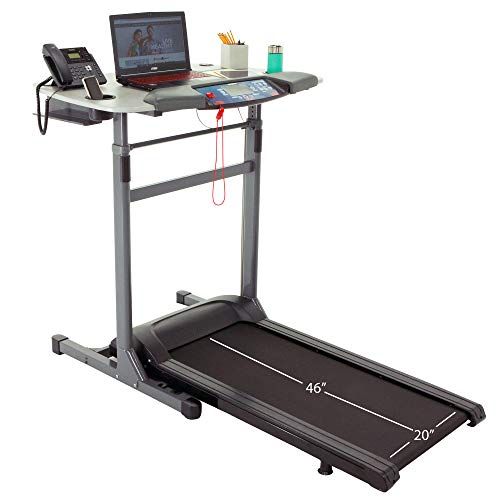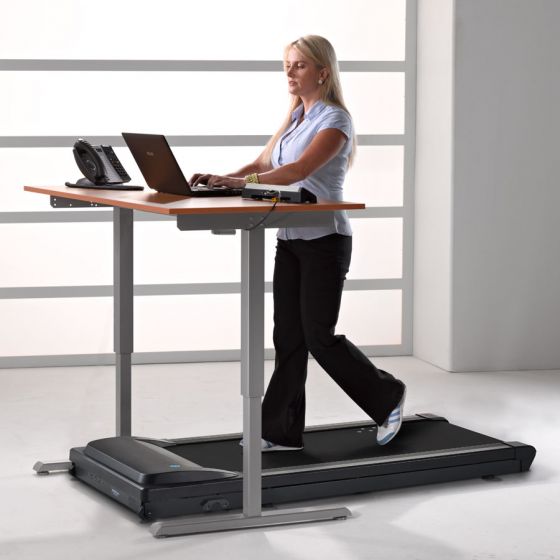“Good posture not only changes your overall appearance, it changes your physiology.”
– Dr. Scott A. Mills
How many steps do you take in one day? Do you know if you take 10,000 steps each day? Regular physical activity, such as walking 10,000 steps a day can boost your heart health plus, lower glucose and insulin levels post meals. [1, 2] Step one is figure out your baseline (starting point) and then add 1000 daily steps each week, so if your baseline is 4000 steps per day, set your goal to 5000 steps each day. Imagine if you had a standing desk treadmill workstation to help you fit in those extra steps per day. [2, 15]
Did you know adding an extra 10,000 steps a day typically burns about 2000 to 3500 calories each week? One pound of body fat equals 3500 calories. Everyone’s metabolism works at different speeds and many factors come into play – gender, age, pre/post menopause, sleep, weight, workout intensity and more. Depending upon your metabolism generally speaking someone could lose about one pound per week by adding an extra 10,000 steps each day.
“Sitting is the new smoking disease” [1]
Research shows some fundamentally negative effects are rooted from sitting for long periods of time.
- Increased risk of heart disease, diabetes, musculoskeletal pain
- Sitting is a risk factor for death
- Mortality rate is increased by 15% for people who sit over 8 hours per day and 40% for people who sit over 11 hours per day
Movement is medicine. A treadmill desk is one possible solution to help you achieve more movement throughout your workday.
Ergonomic Friendly Setup

Distance: Place your monitor about 20 inches in front of you, or at arm’s length. Putting it too close will strain your eyes, while placing it too far away may make you slouch forward in an attempt to read what’s on the screen.
Angle: Your monitor should be placed at an angle of about 10 to 20 degrees. A greater angle will cause you to hold your head at an uncomfortable angle, leading to neck strain.
Height: the top line of your screen should be at or below eye level. Tilting your head back to try to read your monitor can lead to headaches and neck pain.
Lighting: If you’re lucky enough to have a window in your office space, try to avoid facing it or sitting with your back to it. Placing your monitor and desk perpendicular to the window works best. Whatever kind of lighting you use, position the monitor so that there is no distracting glare.
Monitors often come fixed to their stands, making them hard to adjust. Fortunately, there are plenty of adjustable monitor stands available, and it’s relatively easy to improvise something as well. You can try stacking books or reams of printer paper to see what works for you. Once you know what you need, you can go looking for a more permanent solution.
Note the image above relates to the treadmill belt you will be standing on while working.
Selecting a Treadmill Workstation
When you’re shopping for one, keep in mind that you can mix and match components. As long as your standing desk has a high clearance and no cross bars for added support, chances are it’ll work with an under-the-desk treadmill. Here are some questions to ask yourself:
- How much do you expect to use the treadmill desk?
- How much room do you have? Do you already have a space in mind? If so, what are the measurements for the space?
- Is it for an individual or shared workstation? How many people will be using the machine per day?
- Do you need assistance with installation and setup?
So many modern business tasks can be done on a treadmill desk – Skype calls, web research, emails, phone calls, even typing can be done while walking at a slow pace with a properly height-adjusted treadmill desk. Like anything new it does some practice but you can start with just a few minutes a day to improve your muscle memory and confidence before it becomes second nature. Treadmill desk speeds can be adjusted from a very slow to comfortably-paced walk. Keep in mind they’re not made for running or incline use.
Professor Alan Hedge has published several research papers analyzing the health impact on individuals using sit-stand ergonomic workstations and the rate of productivity. He found that low impact movement and transitioning from sitting to standing positions (3.6 times per day) throughout the workday lead to an average of 62% decrease in musculoskeletal complaints. [1] The overall feedback from employees on sit-stand was very positive. The study participants were asked to rate the level of discomfort in their regular seated workstation position in their feet, legs, knees, thighs, buttocks, hands, wrist, lower arms/elbows, lower back middle back, upper back, shoulders, neck and eyes. The same participants were asked to rate the level of discomfort post sit-stand workstation after 3 months of use. Each region of the body showed decreased discomfort levels post sit-stand workstation over 3 months of time, plus, reduced mid-morning and early afternoon to end of day discomfort complaints. [1] The takeaway message from Professor Hedge is sit-stand workstations can be beneficial for your overall health and wellbeing. [1, 8]
Health Benefits [2, 3, 4, 9]
- Improved mood
- Depression relief
- Decreased stroke risk by 20% with 30 minutes of walking per day
- Lowering blood pressure
- Improved sleep habits
- Varied work posture
- Reduced upper body discomfort
- Reduced foot swelling
- Increased productivity taking fewer and shorter breaks
- Enhanced workforce performance
- Improved musculoskeletal conditions (i.e. back pain)
- Decreased back pain
- Increased circulation and blood flow
Researchers studied treadmill speeds and typing performance while walking at 2.25 km/hr. was no different than seated typing performance. The results support the potential of treadmill walking at 2.25 km/hr. to provide low-intensity physical activity without compromising typing performance. [1]
Finding the right workstation specific for you and your needs is subjective. We recommend making a list of what are the key features that are the most important for you and your workstation needs. Note when purchasing an office treadmill they all come from the vendors without an incline function! Keep in in mind, walking at an incline while working is not recommended by ergonomists as it takes your body out of a neutral position and places strain on your back and joints. These treadmills aren’t meant for running purposes while working and have a maximum speed of typically 4.0 MPH unless stated differently from manufacturer.
We accessed each treadmill based on the following criteria:
- Keyboard space
- Ease of use
- Overall stability
- Ergonomics
- Workstation capacity
- Build quality
- Warranty
- Budget
NordicTrack Desk Treadmill (retails for $1499 from NordicTrack)


- Desk and treadmill combo
- Space saver design (can use in standing and seated positions)
- Compact (treadmill can be stored in upright position)
- Adjustable desktop height positions available
- Over-sized 40″ x 18″ work surface
- 0 to 6 MPH
- USB charging station to connect keyboard, mouse, or phone
- LCD display built into desktop allows you to track your distance
- 300 lb. user weight capacity
- 1-year labor warranty
- 10-year frame warranty
- 2-year parts warranty
Exerpeutic 5000 ExerWork 20 Treadmill Desk (retails for $899 from Amazon)

- Desk and treadmill combo
- Treadmill maximum speed of 4.0 MPH (no power walking speed here)
- Adjustable desktop to fit anyone from 5-feet to 6-feet-5-inches tall
- LCD display to track progress during the day
- Cupholders to store items
- Solid frame
IPO Treadmill Smart Walk Compact Treadmill (retails for $499 from Amazon)

- Treadmill only and will need an ergonomic friendly desk workstation
- Super-sleek treadmill can slide underneath a couch or bed from others to see
- Compact yet maximum speed of 4.0 MPH
- Shock absorption running belt
- Super quiet motor
- Without controls at the fingertips the walking experience will of course be different than other treadmills
- The treadmill uses an infrared sensor system to adjust speed
- It detects the walker stepping on and starts the motor
- A three-zone split provides a speed-up area at the front, steady speed zone in the middle and slow-down area at the rear
- The digital display at the top provides a clear readout
iMovR ThermoTread GT Desk Treadmill (retails for $1649 from iMov)
- Treadmill only and will need an ergonomic friendly desk workstation
- Sturdy treadmill meant for multiple users per day
- Silent motor
- Maximum walking speed of 2.5 MPH
- Touch-screen display
- Saved presets for preferred walking speeds for multiple users
- 3-years on motor
- 2-years on parts
- 1-year on labor
- 100-day, 100% Satisfaction Guarantee (20% minus restocking fee)
LifeSpan TR1200-DT3 Under Desk Treadmill (retails for $999 from LifeSpan)
- Treadmill only and will need an ergonomic friendly desk workstation
- Control console can be placed on desk with USB charging port
- 30-Day money back guarantee
- Free shipping
- Fully assemble out of the box
- Easily roll the treadmill under your desk
- Supports up to 350 lbs
- Maximum speed of 4.0 MPH
- Frame: Lifetime warranty
- Motor: 3 Year warranty
- Parts: 2 Year warranty
- Labor: 1 Year warranty
Titan Fitness Under Desk Walking Treadmill (retails for $500 from Titan Fitness)

- Least expensive treadmill option
- Treadmill only and will need an ergonomic friendly desk workstation
- Maximum speed of 4.0 MPH
- Console acts as a tracker by recording distances up to 99.9 miles, steps up to 9999, calories up to 999.9 Kcal, and time up to 99:59 min in a single session. No pause function if you stop for a break. Your data will be lost.
- Maximum weight capacity of 250 lbs
We have more blogs specific about setting up an ergonomic friendly office workstation related to keyboards, chairs, mats, electric vs. manual standing desk converters, bicycling vs. treadmill desk options and more. If you found this blog post helpful please share with your friends, family, co-workers and neighbors.
We have additional blog post specific to pilates, pre/post natal, bone building for osteoporosis/osteopenia, mindful meditation, restorative yoga therapy, partner and endurance training. We believe in treating the whole person with a holistic approach and blend our knowledge and training of movement, nutrition, massage therapy and traditional chinese medicine.
We love teaching mindful movement and are here to support you in your journey. We offer customized online remote training from anywhere in the world. Contact us today to get started and learn to move with less pain and greater ease. We look forward to partnering with you and answering your movement questions and/or concerns.
Assumption of the Risk: By attempting any of the exercises, you do so at your own risk. We make no representations, guarantees or warranties that the information or exercises on this blog are appropriate for you or will result in improvements of your medical condition or function.
Not medical advice or physical therapy. This content is intended to provide information and instructions on general exercises that may help increase strength, mobility, and function for specific areas of the body. It is not intended to be a substitute for obtaining a medical diagnosis or medical or physical therapy advice from a qualified licensed provider. You should seek medical advice from a qualified physician or physical therapist before trying any of the exercises or self-treatment suggestions on this blog, particularly if your pain is from a traumatic injury or event.
References




